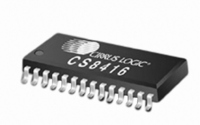CS8416-CNZ Cirrus Logic Inc, CS8416-CNZ Datasheet - Page 25

CS8416-CNZ
Manufacturer Part Number
CS8416-CNZ
Description
IC RCVR DGTL 192KHZ 28QFN COMM
Manufacturer
Cirrus Logic Inc
Type
Digital Audio Interface Receiverr
Datasheet
1.CS8416-CZZ.pdf
(60 pages)
Specifications of CS8416-CNZ
Applications
Digital Audio
Mounting Type
Surface Mount
Package / Case
28-QFN
Audio Control Type
Digital
Control Interface
I2C, SPI
Control / Process Application
AV & DVD Receivers, CD-R, Digital Mixing Consoles
Supply Voltage Range
3.13V To 5.25V, 3.13V To 3.46V
Lead Free Status / RoHS Status
Lead free / RoHS Compliant
For Use With
598-1017 - BOARD EVAL FOR CS8416 RCVR
Lead Free Status / RoHS Status
Lead free / RoHS Compliant, Lead free / RoHS Compliant
Other names
598-1723
DS578F3
7.1
Slip/Repeat Behavior
When using the serial audio output port in slave mode with an OLRCK input that is asynchronous to the
incoming AES3 data, the interrupt bit OSLIP (bit 5 in the Interrupt 1 Status register, 0Dh) is provided to in-
dicate when repeated or dropped samples occur. Refer to
When the serial output port is configured as slave, depending on the relative frequency of OLRCK to the
input AES3 data (Z/X) preamble frequency, the data will be slipped or repeated at the output of the CS8416.
After a fixed delay from the Z/X preamble (a few periods of the internal clock, which is running at 256Fs),
the circuit will look back in time until the previous Z/X preamble and check which of the following conditions
occurred:
1. If during that time, the internal data buffer was not updated, a slip has occurred. Data from the previous
2. If during that time the internal data buffer did not update between two positive or negative edges (de-
3. If during that time, it did see a positive edge on OLRCK (or negative edge if the SOLRPOL is set to 1)
If the user reads OSLIP as soon as the event triggers, over a long period of time the rate of occurring INT
will be equal to the difference in frequency between the input AES data and the slave serial output LRCK.
The CS8416 uses a hysteresis window when a slip/repeat event occurs. The slip/repeat is triggered when
an edge of OLRCK passes a window size from the beginning of the Z/X preamble. Without the hysteresis
window, jitter on OLRCK with a frequency very close to Fs could slip back and forth, causing multiple slip/re-
peat events. The CS8416 uses a hysteresis window to ensure that only one slip/repeat happens even with
jitter on OLRCK
frame will be output and OSLIP will be set to 1. Due to the OSLIP bit being “sticky,” it will remain 1 until
the register is read. It will then be reset until another slip/repeat condition occurs.
pending on OLRPOL) of OLRCK, a repeat has occurred. In this case, the buffer data was updated twice,
so the part has lost one frame of data. This event will also trigger OSLIP to be set to 1. Due to the OSLIP
bit being “sticky,” it will remain 1 until the register is read. It will then be reset until another slip/repeat
condition occurs.
no slip or repeat has happened. Due to the OSLIP bit being “sticky,” it will remain in its previous state
until either the register is read or a slip/repeat condition occurs.
X
Channel A
Data
Frame 191
Y
Channel B
Data
Figure 8. AES3 Data Format
Z
Channel A
OLRCK (in slave mode)
Data
Frame 0
Preambles
Y
Channel B
Data
Figure 8
X
for the AES3 data format diagram.
Channel A
Data
Frame 1
Y
Channel B
Data
CS8416
25
















